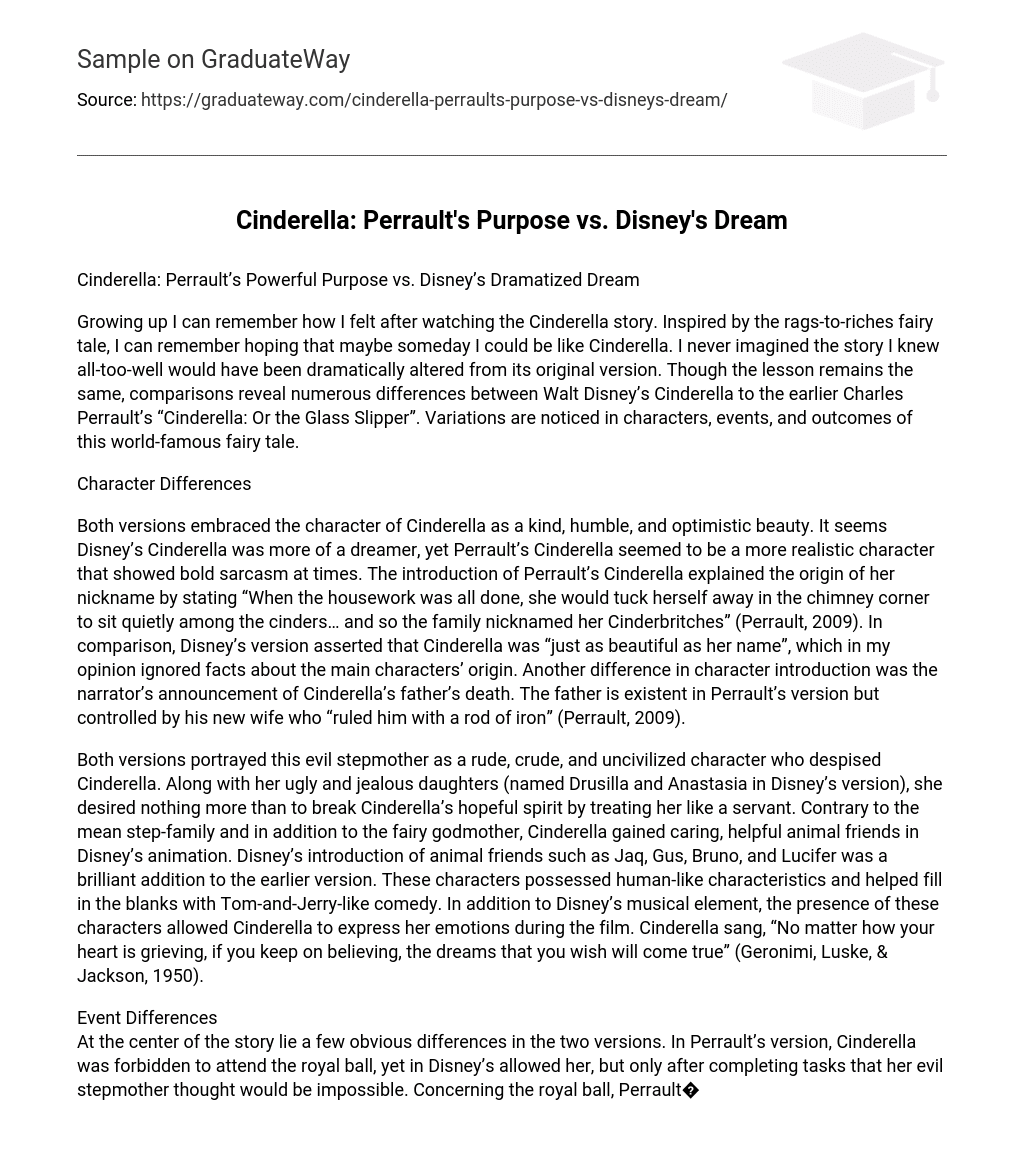Cinderella: Perrault’s Powerful Purpose vs. Disney’s Dramatized Dream
Growing up I can remember how I felt after watching the Cinderella story. Inspired by the rags-to-riches fairy tale, I can remember hoping that maybe someday I could be like Cinderella. I never imagined the story I knew all-too-well would have been dramatically altered from its original version. Though the lesson remains the same, comparisons reveal numerous differences between Walt Disney’s Cinderella to the earlier Charles Perrault’s “Cinderella: Or the Glass Slipper”. Variations are noticed in characters, events, and outcomes of this world-famous fairy tale.
Character Differences
Both versions embraced the character of Cinderella as a kind, humble, and optimistic beauty. It seems Disney’s Cinderella was more of a dreamer, yet Perrault’s Cinderella seemed to be a more realistic character that showed bold sarcasm at times. The introduction of Perrault’s Cinderella explained the origin of her nickname by stating “When the housework was all done, she would tuck herself away in the chimney corner to sit quietly among the cinders… and so the family nicknamed her Cinderbritches” (Perrault, 2009). In comparison, Disney’s version asserted that Cinderella was “just as beautiful as her name”, which in my opinion ignored facts about the main characters’ origin. Another difference in character introduction was the narrator’s announcement of Cinderella’s father’s death. The father is existent in Perrault’s version but controlled by his new wife who “ruled him with a rod of iron” (Perrault, 2009).
Both versions portrayed this evil stepmother as a rude, crude, and uncivilized character who despised Cinderella. Along with her ugly and jealous daughters (named Drusilla and Anastasia in Disney’s version), she desired nothing more than to break Cinderella’s hopeful spirit by treating her like a servant. Contrary to the mean step-family and in addition to the fairy godmother, Cinderella gained caring, helpful animal friends in Disney’s animation. Disney’s introduction of animal friends such as Jaq, Gus, Bruno, and Lucifer was a brilliant addition to the earlier version. These characters possessed human-like characteristics and helped fill in the blanks with Tom-and-Jerry-like comedy. In addition to Disney’s musical element, the presence of these characters allowed Cinderella to express her emotions during the film. Cinderella sang, “No matter how your heart is grieving, if you keep on believing, the dreams that you wish will come true” (Geronimi, Luske, & Jackson, 1950).
Event Differences
At the center of the story lie a few obvious differences in the two versions. In Perrault’s version, Cinderella was forbidden to attend the royal ball, yet in Disney’s allowed her, but only after completing tasks that her evil stepmother thought would be impossible. Concerning the royal ball, Perrault’s version of the event was over two-night period, while Disney’s version was only one night. I believe Disney minimized this to ignore Perrault’s more realistic and self-sufficient character that disobeyed not once, but twice in order to seek her own happiness. In contrast, Disney chose to enhance Cinderella’s reaction with a more love-stricken bliss as she daydreams while humming to the song that she and Prince Charming sang together “So this is love…” (Geronimi, Luske, & Jackson, 1950). During the slipper scene of Disney’s Cinderella, the evil stepmother attempted to destroy Cinderella’s destiny by locking her in her room and going so far as to trip the Grand Duke causing him to drop the glass slipper. Disney created suspense and made viewers think that Cinderella may not live “happily ever after”, after all.
Outcome Differences
Though the stories outcomes were debatably different, both versions ultimately ended with Cinderella marrying the prince. Perrault embraced the truism of the story by allowing the stepsisters to apologize to Cinderella for treating her so badly. True to her character, Cinderella “forgave them with all her heart” (Perrault, 2009). Furthermore, Cinderella arranged for both sisters to be married on the same day. Perrault concluded with a moral statement declaring that: “beauty is a fine thing… but charm is beyond price and worth more… more than a happy ending” (Perrault, 2009). Perrault’s ending reinforced the readers’ understanding of text and provided a good explanation of the purpose behind the tale while reinforcing readers understanding of text. Disney’s version merely ended soon after the shoe fit with a “happily ever after” wedding.
Conclusion
In the end, I found Perrault enforced reality in a classic teaching that both entertained and delivered a true princess. I felt Disney portrayed dream-like behaviors and unrealistic “love”. Disney disregarded facts and dramatized scenes to appeal to large audiences for generations to come, which very successfully fulfilled Disney’s dreams.
References
Geronimi, C., Luske, H., & Jackson, W. (Directors). (1950). Cinderella [Motion Picture]. Perrault, C. (2009). Cinderella: or the little glass slipper. In B. Karasek, & M. Hallett, Folk & fairy Tales (pp. 97-102). Toronto: Broadview Press.





